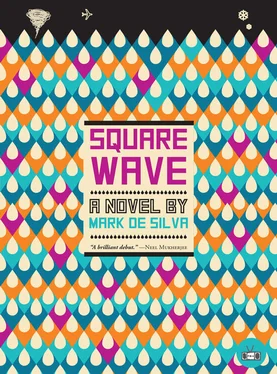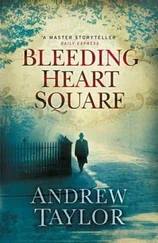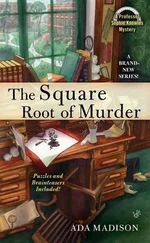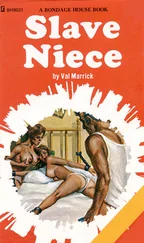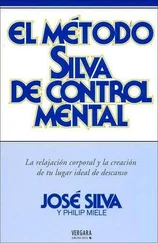Couldn’t heavier use of melody, more formal orchestration and harmonic structure, produce something less numbing, more agile? And could it even be set to words, not as Partch did, but in more vernacular forms — Dianogah, Slint, Boris, all the bands Moto was so deeply schooled in. Something that could escape the ghettos of art music, the concert hall. Something continuous with the decentered brutishness of the city and ripe for unintended consequences. Everything depended, though, on finding the right musical cohort.
Eight vintage analog synthesizers, bought on the cheap from Columbia’s Computer Music Center, which was set to scrap them, sat on a long table across from Larent. Here was his lab. As he surveyed the equipment Larent thought of Alvin Lucier’s famous experiments at Brandeis, back in the 1960s: the construction of feedback loops, recorded voices that descended into unintelligibility, overtaken by their own constituent frequencies, reinforced unevenly till they fell into a chasm of static.
And what about Steve Reich’s lab from that era? Larent seemed to remember hearing that it was really the mechanical defects of those tape loops, their incapacity to sustain any sort of constancy, that was at the core of the phase effects Reich was renowned for. More remarkable to him, though, was the idea of Reich spending much of the noisy sixties — maybe the last time society had seemed so malleable — painstakingly splicing tape loops in a soundproof lab. Yet he was never not political. It’s Gonna Rain and Come Out proved that. As a performer, Larent had spent most of his time out in the world. Somehow that hadn’t done much to clarify the nature of his engagement with it.
He switched the synths into oscillator mode, where they produced un natural tones, simples, the equivalent of partials — single frequencies uncluttered with natural overtones.
He flipped the first of them on. It hummed and buzzed and then produced a disembodied C, akin to a flute in the higher registers. Above this, at a lower volume, he added the second harmonic, the octave. To these he added six more partials: the just fifth, another octave, the just third, and so on through the overtone series. This naturalized the C, incarnated it, forced it into the unsynthesized world.
He altered the amplitudes of the partials, pushing some of the faders up, others down, all in slow, continuous movements, waves, mutating the texture of the C. None corresponded exactly to real instruments, but all corresponded to possible ones. First the tone fluttered and roughened in the direction of a trombone. Another distribution of amplitudes turned it breathy and woody. Then the breathiness fell away and the tone sharpened into something like a violin. Finally he pulled the faders down, all but the first, and the glassy sheen of a fundamental defeating its overtones returned.
With enough oscillators to recreate ever-higher partials, and with enough time, the entire timbral range could be mapped. Every route through this terrain corresponded to a continuous manipulation of overtone amplitudes.
The materials for a performance, perhaps. Moto on drums. Electric strings, a guitar tracing a justly intoned horizontal line, low leading tones with enharmonics restored, all set against a simple vertical construction. Promising, yes, but it would take a very particular sort of guitarist to make it work.
He turned the oscillators back into synths. A middle C sounded from the first of them, an E a pure third up from the second, a pure fifth G from the next, and a Bb on the one after — the greater minor seventh (9:5). Between the third scale degree and the flattened seventh was an interval now slightly wide of a diminished fifth (64:45). So Larent dropped the seventh down by ear, through heavy beating, and arrived at the consonant dissonance of the lesser minor seventh (16:9). The diminished fifth took shape.
More corrections. The minor third from the G to the Bb was still wide, so he took the seventh down still further, the pitch slider drifting down the oscillator’s base, the tone wobbling quickly and then less quickly, settling into an even flatter version of the minor seventh (7:4). The lesser septimal tritone (7:5), the purest, most consonant type of diminished fifth, locked into place and the chord rang out, the overtones reinforcing each other, creating the effect of a distinct binding tone.
Larent sat back down, away from the oscillators, and let the chord draw him in, the harmonic seventh: the barbershop chord, so called for its a cappella uses. He imagined the Crip walkers then, asphalt dancers with picks buried in lightless hair, isolating this constellation, the background hum of another world, together, a dozen of them in that circle. All the while, their immaculate sneakers kept gliding across the pavement, and the men kept whirring about the circle, their motion counter-pointed only by that peculiar chord they would hold until their lungs were raw.
The spotted slate tie in woven silk, cross-knotted between the spread collar of a bespoke oxford; the single-button, summer-weight Huntsman, cut long, in gunmetal blue; the flannel trousers, chocolate, unpleated and uncuffed; and the whiskey brogues, one dangling — Kames’s legs were crossed — its sole scraped down to an ashen canvas speckled black and tan.
He clutched the papers with both hands: a few draft essays, a letter of introduction from Hade, a vita. Thirty or forty sheets in all. The high-armed chair, lacquered maple wrapped in blue leather, softly whined as Kames shifted forward and, studying the CV, returned a curl of hair to the place behind his ear.
“Intellectual history,” he said.
“Well, more history of ideas, I think,” Stagg began. “Told, it’s true, through the history of Anglo-American philosophy. Basically, the evolution of modern moral thought, political thought, alongside ideas about the mind — action, personal identity, consciousness — within the analytic tradition, from the mid-nineteenth century on. Which means Mill through Sidgwick and Moore, down to Williams and Parfit. And then for the mind, Brentano, Frege, Russell and Ryle, through to Quine, Austin, Davidson, Dummett, and McDowell.”
Stagg waited for Kames to speak, but the director kept his head turned away from him, apparently in concentration.
“And then there’s some discussion,” Stagg continued, “though it’s not really enough, of how this all relates to wider ideas of morals and minds in Britain and America, the ethical sensibilities of the culture, its sense of itself as a political body and as a collection of individuals. But that was more of an afterthought. Future work, I think.”
Kames turned back to Stagg slowly. “But is there any gesture toward more classically continental thinkers?” he asked. “I’m thinking first of Freud, but also, politically, of Habermas, Strauss… Schmitt even.”
“To a degree. Only if they mark the philosophical tradition I’m working on. Usually the influence, for the continental thinkers, runs through the general culture, whatever it soaks up, and then back to analytic philosophy. So, Freud. Unignorable stuff, not necessarily because it has intellectual credibility — I’m not sure it does at this point — but because it became common sense, a feature of the culture, to be explained like any other. Even its mistakes need an explanation. Nietzsche, the same thing.
“But Schmitt, say, or Althusser, not really,” Stagg said. “They haven’t been absorbed by common sense, not so deeply, not yet, anyway, so they’ve never had to be dealt with by the other tradition. Even if they might have a lot more going for them, intellectually speaking, than Freud. I don’t know. I do have some material on Schopenhauer and Hegel, and also Foucault, since they helped form the ideas I’m looking at, negatively at least.”
Читать дальше
